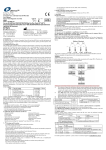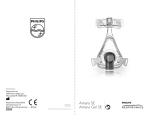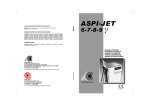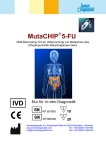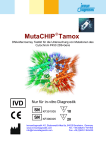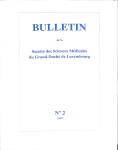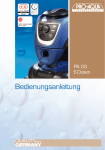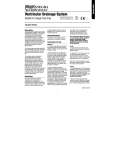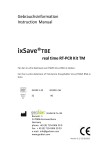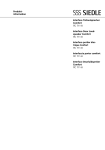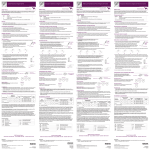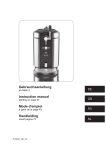Download Arbeitsanleitung - bei Immundiagnostik
Transcript
MutaPLATE Enterovirus ® real time RT-PCR Kit Screening Test für den Nachweis humaner Enterovirus RNA (Polio-, Coxsackie A-, Coxsackie B- und Echoviren) in klinischen Proben mittels offenen (z. B. Mikrotiterplattenformat) real time PCR - Systemen (z. B. von Applied Biosystems, Stratagene, Corbett Research: RotorGene, Cepheid: SmartCycler, etc.) sowie im LightCycler 480 (Roche). KG1900232 KG1900296 Nur für in vitro Diagnostik Immundiagnostik AG, Stubenwald-Allee 8a, 64625 Bensheim, Germany www.immundiagnostik.com Tel.: +49 (0)6251/ 701900 [email protected] Fax: +49 (0)6251/ 849430 Stand: 22.03.2011 1 N:WINDAT/AL/MB/K/MPEV 1. VERWENDUNGSZWECK Der MutaPLATE® Enterovirus real time RT-PCR Kit ist ein qualitativer Screening-Test zum Nachweis von Enterovirus RNA (Polio-, Coxsackie A-, Coxsackie B- und Echoviren) in klinischen Proben (Stuhl, Vollblut, Plasma, Respirationstraktproben, CSF (cerebrospinal fluid) und anderen Körperflüssigkeiten) mittels offenen (z. B. Mikrotiterplattenformat) real time PCR Systemen (z. B. von Applied Biosystems, Stratagene, Corbett Research: RotorGene, Cepheid: SmartCycler, etc.) sowie im LightCycler 480 (Roche). 2. EINLEITUNG Humane Enteroviren sind ubiquitär vorkommende, hochinfektiöse Krankheitserreger, die zur Familie der Picornaviridae gehören. Die mit hoher Inzidenz (weltweit ca. 500 Millionen Infektionen/ Jahr) vorkommenden Pathogene sind kleine unbehüllte RNA-Viren, die sehr resistent gegenüber Umwelteinflüssen sind. So behalten Enteroviren selbst bei pH-Werten 3 – 9 sowie in Anwesenheit von Detergenzien ihre Infektiosität. Bislang sind ca. 70 verschiedene Serotypen beschrieben aber kein effektives antivirales Chemotherapeutikum zur Bekämpfung der Viren ist verfügbar. Die Übertragung der Viren erfolgt von Mensch zu Mensch fäkal-oral , d.h. ausschließlich über Kontakt- und Schmierinfektion. Kontaminierte Lebensmittel/ Trinkwasser stellen dabei eine wichtige Infektionsquelle dar. Das Virus kann noch über Wochen nach der akuten Erkrankung mit dem Stuhl ausgeschieden werden. Enterovirusinfektionen können das ganze Jahr über auftreten und lebensbedrohende Infektionen hervorrufen (insbesondere bei Kindern). Im Sommer kommt es in Deutschland zu Häufungen der Infektionen aufgrund kontaminierter Badegewässer (Schwimmbad, See). Enteroviren lösen zahlreiche Krankheitsbilder aus, z. B. Infektionen des oberen Respirationstrakts, „Sommergrippe“, Herpangina, Hand-Fuß-Mund-Krankheit, jugendlicher Diabetes mellitus, Infektionen des Gastrointestinaltrakts, Augeninfektionen, oder epidemische Myalgie. Aber auch Myocarditis, Paralysis, multiples Organversagen, Meningitis und Encephalitis sind häufig mit einer Enterovirusinfektionen assoziiert. 3. TESTPRINZIP MutaPLATE® Enterovirus real time RT-PCR enthält spezifische Primer, Hydrolysis-Sonden und weitere Reagenzien zur Detektion von Enterovirus RNA in offenen real time PCRSystemen. Stuhlproben oder andere klinische Proben, wie z.B. Vollblut, Plasma, Respirationstrakt-Proben, CSF (cerebrospinal fluid), etc. können als Ausgangsmaterial für die RNA-Extraktion und den nachfolgenden Erregernachweis eingesetzt werden. Zielsequenz zur Detektion ist innerhalb der 5`-untranslatierten Region (5`-UTR) des Enterovirus-Genoms. Während der PCR wird die Spezifität des entstandenen Amplikons durch real time Hybridisierung und anschließende Hydrolyse von Enterovirus-spezifischen Sonden (mit Fluorophor- und Quencher- Molekül markierte Oligonukleotide) überprüft. Bei spezifischer Enterovirus-Amplifikation wird ein Fluoreszenssignal emmittiert, welches von der optischen Einheit des real time PCR (Mikrotiterplatten-)Systems (ABI: PRISM SDS-, Stratagene: MxPRO-, Corbett Research: Rotor Gene 3000/ 6000- Software) detektiert wird: Enterovirusspezifische Amplifikation wird dabei mittels FAM-Fluoreszenz (470/ 510 nm) gemessen. Zudem überprüft eine in jede Reaktion eingeschlossene interne Kontrolle, welche parallel zu den Erregersequenzen koamplifiziert und detektiert wird, eine mögliche RT- bzw. PCRInhibition: Die Detektion dieser amplifizierten internen Kontrolle wird mittels VIC (bzw. HEX/ JOE) - Fluoreszenz (530/ 555 nm) gemessen. Stand: 22.03.2011 2 N:WINDAT/AL/MB/K/MPEV 4. KITBESTANDTEILE Jedes Testkit enthält Reagenzien zur Durchführung von 32 bzw. 96 Bestimmungen, sowie eine Gebrauchsanleitung. Bezeichnung Reagenz A1 Enzym Mix A2 Primer-/ Sonden Mix A3 A4 Konfektion 32 1x 26 µl Konfektion 96 3x Deckelfarbe 26 µl blau 1 x 460 µl 3 x 460 µl gelb Positivkontrolle 1x 50 µl 2x 50 µl rot Negativkontrolle 1x 50 µl 1x 50 µl grün 5. ERFORDERLICHE LABORGERÄTE UND HILFSMITTEL Benötigte Materialien - mitgeliefert: Reagenzien für die real time RT-PCR in offenen Systemen (z.B. Mikrotiterplatten) Gebrauchsanweisung Benötigte Materialien - nicht mitgeliefert: real time PCR-System, z. B. Applied Biosystems, Stratagene, Corbett Research: RotorGene, Cepheid: SmartCycler oder Roche: LightCycler 480, etc.. PCR-Reaktionsgefäße (oder optische Mikrotiterplatten mit transparenten optischen Abdeckfolien). Tischzentrifuge (13000 rpm) und Kühlbehälter für PCR-Gefäße. RNA-Extraktionskit für Stuhlproben (z. B. MutaCLEAN® Stool (Viral RNA), KG1035, Immundiagnostik). Pipetten (0,5 – 1000 µl) mit sterilen Filterspitzen. sterile Reaktionsgefäße (1,5 und 2,0 ml). 6. LAGERUNG UND HALTBARKEIT Alle Reagenzien (A1 bis A4) sollten bis zum unmittelbaren Gebrauch bei <-20°C gelagert werden. Ein mehrfaches Auftauen/ Einfrieren der Reagenzien A1, A2, und A3 ist unbedingt zu vermeiden (bei Bedarf nach dem erstmaligem Auftauen geeignete Aliquots herstellen und die Reagenzien dann sofort wieder einfrieren). Während der PCR-Vorbereitung alle Arbeitsschritte zügig in einem Kryobehälter durchführen bzw. alle Reagenzien stets geeignet kühlen. Primer-/ Sonden-Mix (A2) vor Lichtkontakt schützen. Alle Reagenzien können bis zum Ablauf des (auf der Kit-Packung angegebenen) Mindesthaltbarkeitsdatum verwendet werden. Stand: 22.03.2011 3 N:WINDAT/AL/MB/K/MPEV 7. HINWEISE UND VORSICHTSMAßNAHMEN Nur zur in vitro Diagnostik. Dieser Test muss durch speziell in Molekularbiologie-Techniken geschultes Personal durchgeführt werden. Die klinischen Proben müssen als potentiell infektiöses Material angesehen und entsprechend auch entsorgt werden. Die Regeln der Good Laboratory Practice (GLP) müssen eingehalten werden. Testkit nach Ablauf des Mindesthaltbarkeitsdatum nicht mehr verwenden. AMPLIFIKATION: Die PCR-Technologie ist sehr sensitiv, d. h. die Vermehrung eines einzelnen Moleküls generiert Millionen identischer Kopien. Diese Kopien können in Form von Aerosolen entweichen und sich auf Unterlagen in der Umgebung festsetzen. Um eine Kontamination von Proben mit Amplifikaten aus vorausgegangenen Experimenten zu vermeiden, sollte in drei (möglichst auch räumlich) von einander getrennten Bereichen gearbeitet werden und zwar: 1) 2) 3) Bereich, in dem die Proben vorbereitet werden. Bereich, in dem der Master-Mix angesetzt wird. Bereich, in dem der Master-Mix und die Proben-RNA in die PCR-Gefäße pipettiert werden. Pipetten, Reaktionsgefäße und andere Arbeitsmittel sollten nicht innerhalb dieser drei verschiedenen Arbeitsbereiche zirkulieren. Sterile Pipettenspitzen mit Filtereinsatz benutzen. Aerosolbildung vermeiden. Für jeden Arbeitsplatz neue Handschuhe benutzen und Kittel tragen. Regelmäßig Pipetten und Laborbänke dekontaminieren (keine ethanolhaltigen Lösungen benutzen). 8. TESTDURCHFÜHRUNG Die gesamte Durchführung ist in folgende drei Schritte aufgeteilt: A) RNA-Extraktion (aus Stuhlproben). B) Reverse Transkription der RNA und nachfolgende Amplifikation/ kombinierte Detektion der entstandenen cDNA-Templates mittels der Hybridisierungssonden. C) Interpretation der Ergebnisse mit Hilfe der Software des verwendeten real time PCRKapillarsystems. A) PROBENVORBEREITUNG 1) Die Extraktion viraler RNA wird mit Hilfe eines kommerziell erhältlichen RNAIsolierungs-Kits (z. B. MutaCLEAN® Stool (Viral RNA), KG1035 von Immundiagnostik) aus Stuhlproben bzw. anderen klinischen Proben (Vollblut, Plasma, Respirationstraktproben, CSF [cerebrospinal fluid] etc.) durchgeführt und erfolgt entsprechend den Angaben des Herstellers. Dazu bei: a) Stuhlproben: eine „erbsengroße“ Stuhlmenge in ca. 1,5 ml sterilem (Reinst-)wasser (keine Puffer verwenden) aufschwemmen, gut vortexen und nach Absinken der festen Bestandteile (gegebenenfalls 2 min bei 5000 rpm in einer Tischzentrifuge zentrifugieren) den Überstand als Ausgangsmaterial verwenden. Sehr flüssige Stuhlproben können auch direkt, also ohne vorherige Aufschwemmung, zur Extraktion eingesetzt werden (aber auch hier gut vortexen und nach ggf. notwendigem zentrifugieren (2 min 5000 rpm) den Überstand unverdünnt verwenden. Stand: 22.03.2011 4 N:WINDAT/AL/MB/K/MPEV b) Liquor: Liquorproben werden unmittelbar (nativ) in die Extraktion eingesetzt. c) Abstrichtupfer (Bläscheninhalt): Abstrichtupfer zunächst in 500 µl sterilem (Reinst-)Wasser einweichen lassen, dann gut vortexen. Anschließend den Tupfer entnehmen und die verbleibende Flüssigkeit zur Extraktion einsetzen. 2) Falls die real time PCR nicht sofort durchgeführt wird, müssen die Proben bei < -20°C aufbewahrt werden. B) REAL TIME Enterovirus (MutaPLATE) RT-PCR PROTOKOLL Es ist ratsam, das gesamte Protokoll zu lesen, bevor mit der Durchführung begonnen wird. Der Ansatz einer Gesamtmenge an Master-Mix für die jeweilige Anzahl an Proben und die entsprechenden Kontrollen sollte folgendermaßen erfolgen: 1) Die Enzym-Mix Menge für eine Reaktion mit der Anzahl (N) der durchzuführenden Reaktionen (inklusive Kontrollen A3 und A4) multiplizieren und zum Ausgleich der Pipettierungenauigkeit einen zusätzlichen (virtuellen) Ansatz berechnen. Mit allen weiteren Reagenzien in der gleichen Weise verfahren. Reagenzien während der Arbeitsschritte stets geeignet kühlen! Reaktionsvolumen Master-Mix Volumen 0,8 µl Enzym-Mix (A1) 0,8 µl x (n +1) 14,2 μl Primer- und Sonden-Mix (A2) 14,2 μl x (n +1) 2) Die folgenden Reagenzien in einem sterilen Reaktionsgefäß durch mehrmaliges Aufund Abpipettieren (ca. 15 – 20 x) gut mischen (NICHT VORTEXEN !): Enzym-Mix (A1) und Primer-/ Sonden-Mix (A2). Diese Mischung stellt den Master-Mix dar; kurz in einer Tischzentrifuge abzentrifugieren. 3) 15 µl des Master-Mix mit einer Mikropipette und sterilen Filterspitzen in jede der LightCycler® Kapillaren pipettieren. 5 µl der Proben-RNA bzw. Positiv- und NegativKontrollen (A3 und A4) zu den jeweiligen Kapillaren zupipettieren (es empfiehlt sich zuerst die Negativkontrolle zu pipettieren und diese erst am Schluss zu verschließen, um Kontaminationen zu überprüfen). Die Kapillaren jeweils unverzüglich verschließen, um Kontaminationen zu vermeiden und dann in einer LightCycler® Kapillar-Zentrifuge kurz abzentrifugieren. 4) Folgendes LightCycler® RT-PCR Protokoll durchführen: 50°C für 95°C für 10 min 10 min reverse Transkription initiale Denaturierung 95°C für 53°C für 72°C für 15 sec 30 sec 15 sec 45 Zyklen ramping time: 20°C/sec – aqu. mode here: SINGLE 4°C für 10 sec Abkühlung (ev. gerätebedingt Raumtemperatur) Stand: 22.03.2011 5 N:WINDAT/AL/MB/K/MPEV C) RT-PCR ANALYSE UND INTERPRETATION DER ERGEBNISSE 1) Durchführung der real time RT-PCR im entsprechenden offenen System. 2) Enterovirus spezifische Amplifikation wird mittels FAM – Fluoreszenz (bei Source 470/ Detector 510 nm) detektiert. Die interne Kontrolle wird mittels VIC (bzw. HEX/ JOE) - Fluoreszenz (bei Source 530/ Detector 555 nm) gemessen. Folgende Einstellung sollten für die Bestimmung von Reporter-/ Quencher-Molekülen mit der ABI PRISM SDS-Software (bzw. der vergleichbarer Instrumente) gewählt werden: Detection Reporter Quencher Enterovirus RNA: 510 nm FAM None Interne Kontrolle: 555 nm VIC (HEX / JOE) None 3) Folgende Resultate sind möglich: 1) Es wird FAM-Fluoreszenz wird detektiert. Das Ergebnis ist positiv: die Probe enthält Enterovirus - RNA. In diesem Fall ist die Detektion der VIC (bzw. HEX / JOE) - Fluoreszenz nicht notwendig, da hohe Enterovirus cDNA- Konzentrationen zu einem verminderten/ fehlenden Fluoreszenz-Signal der internen Kontrolle führen kann (Kompetition). 2) Es wird keine FAM-Fluoreszenz detektiert, jedoch eine VIC (bzw. HEX / JOE) Fluoreszenz (Signal der internen Kontrolle). Das Ergebnis ist negativ: Die Probe enthält keine Enterovirus - RNA. Das detektierte Signal der internen Kontrolle schließt die Möglichkeit einer RTPCR-Inhibition aus. 3) Weder FAM-, noch VIC (bzw. HEX / JOE) - Fluoreszenz wird detektiert. Es kann keine diagnostische Aussage gemacht werden. Die PCR-Reaktion wurde inhibiert. PC NC Stand: 22.03.2011 6 N:WINDAT/AL/MB/K/MPEV MutaPLATE Enterovirus ® real time RT-PCR Kit Version 2011 For detection of Enterovirus-RNA (Polio-, Coxsackie A-, Coxsackie Band Echovirus) in clinical samples using open real time PCR systems (e. g. Applied Biosystems ABI, Corbett Research: RotorGene, Cepheid: Smart Cycler, Stratagene: Mx3500, Amplifa: ECO, sowie Roche: Light Cycler 480). KG1900232 KG1900296 For in vitro diagnostic use only Immundiagnostik AG, Stubenwald-Allee 8a, 64625 Bensheim, Germany www.immundiagnostik.com Tel.: +49 (0)6251/ 701900 [email protected] Fax: +49 (0)6251/ 849430 Date: 2011/03/22 1 N:WINDAT/AL/MB/K/eMP EV 1. INTENDED USE The MutaPLATE® Enterovirus real time RT-PCR kit is an assay for the specific detection of Enterovirus-RNA (Polio-, Coxsackie A-, Coxsackie B- and Echoviruses) in stool samples, respiratory samples, liquor or vesicle fluid using open real time RT-PCR systems (e. g. from ABI, Corbett Research: RotorGene, Cepheid: Smart Cycler, Stratagene: Mx3500, Amplifa: ECO, sowie Roche: Light Cycler 480). 2. INTRODUCTION Enteroviruses are highly contagious pathogens belonging to the family of Picornaviridae. They are small, non-enveloped ssRNA-viruses which are very resistant to environmental conditions. Even at pH 3-9 or in the presence of detergence Enteroviruses remain infectious. Thus far, there are no effective antiviral chemotherapeutics available. Until now about 70 serotypes are known. The transmission from person to person mainly is fecal-orally. Contaminated foods and drinking water are important sources of infection. The viruses can be egested in stool even weeks after an acute infection. Infections with Enteroviruses can occur throughout the year, however, in summer, contaminated water in swimming pools or lakes lead to an increased number of Enterovirus infections. The symptoms caused by Enteroviruses are numerous: infections of the upper respiratory tract, undifferentiated fever, herpangina, hand-foot-mouth-disease, rash disease, paralyses, etc.. 3. PRINCIPLE OF THE TEST The MutaPLATE® Enterovirus contains specific primers and fluorescence-labelled hydrolysis probes for the detection of Enterovirus-RNA in clinical samples. Human stool samples or other clinical samples, such as whole blood, plasma, respiratory samples, CSF (cerebrospinal fluid) etc. can be used as starting material for RNA-extraction and subsequent pathogen analysis with MutaPLATE® Enterovirus real time RT-PCR Kit. The reverse transcription (RT) of potentially present viral RNA to cDNA and the subsequent amplification of Enterovirus-specifc fragments are performed in a one step RT-PCR. The target sequence for the detection is located in the 5`-untranslated region (5`-UTR) of the viral genome. Detection of Enterovirus amplificates is achieved in real time by hybridization and subsequent hydrolysis of Enterovirus-specific fluorescence probes. Their emitted signal is measured (during the PCR process) by the optical unit of the real time PCR system in use (ABI: PRISM SDS-, Stratagene: MxPRO-, Corbett Research: RotorGene 3000/ 6000-, Cepheid: SmartCycler-, Roche: LC480software). Enterovirus-specific amplification is measured in the FAM- channel (470/ 510 nm). Furthermore, MutaPLATE® Enterovirus real time RT-PCR Kit contains also a separate RNA Internal Control (IC) which is detected in a second independent amplification system. This IC allows the detection of a potential inhibition of the reverse transcription or the PCR. By doing so, the risk for false-negative results is minimized extensively. The fluorescence of the RNA internal control is measured in the VIC/ HEX/ JOE/ TET- channel (530/ 555 nm). Date: 2011/03/22 2 N:WINDAT/AL/MB/K/eMP EV 4. KIT CONTENT Each kit contains enough reagents to perform 32 or 96 tests (the vials contain the indicated amounts and a further surplus) and also a package insert. Please check provided manual always for current date and use it together with the reagents in the kit Reagent A1 Enzyme Mix A2 Primer-/ Probe Mix/ IC A3 A4 Confection 32 1x 26 µl Confection 96 3x 26 µl Colour blue 1 x 460 µl 3 x 460 µl yellow Positive Control 1x 50 µl 2x 50 µl red Negative Control 1x 50 µl 2x 50 µl green 5. TEST PERFORMANCE Required materials - provided: Reagents for real time RT-PCR Package insert Required materials - not provided: Real time PCR instrument (e. g. from ABI, Stratagene: Mx3500, Corbett Research: Rotor Gene, Cepheid: Smart Cycler, Amplifa: ECO or Roche: Light Cycler 480) PCR reaction tubes (or optical microtiter plates with transparent optical covers) Table centrifuge (13000 rpm), Vortexer and Cryo-container for PCR tubes RNA extraction kit for stool samples (e. g. MutaCLEAN® Stool (Viral RNA), KG1035, from Immundiagnostik) Pipettes (0.5 µl – 200 µl) with sterile filter tips sterile reaction tubes (1,5 ml and 2,0 ml) 6. STORAGE AND HANDLING The MutaPLATE® Enterovirus real time RT-PCR Kit is shipped on dry ice. All components must be stored at -20°C in the dark immediately after receipt. Do not use reagents after the date of expiry printed on the package. After initial usage, reagents are stable for up to six months. The reagents should not be thawed and frozen more than 2 times. If necessary, the Primer-Probe-Mix and the Positive Control have to be aliquoted. 7. WARNINGS AND PRECAUTIONS For in vitro diagnostic use only. This assay needs to be carried out by in Molecular Biology methods skilled personnel Clinical samples should be regarded as potentially infectious materials and all equipment used has to be treated as potentially contaminated This assay needs to be run according to GLP (Good Laboratory Practice) Stick to the protocol described below Do not use the kit after its expiration date The Enzyme-Mix is liquid even at -18°C. Take it out of the freezer shortly before usage and put it back immediately Don`t combine MutaPLATE® Enterovirus kit components with different lot numbers. Date: 2011/03/22 3 N:WINDAT/AL/MB/K/eMP EV AMPLIFICATION: The PCR technology is utmost sensitive. Thus, amplification of a single molecule generates millions of identical copies. These copies may evade through aerosols and sit on surfaces. In order to avoid contamination of samples with RNA which previously was amplified, it is important to physically strictly divide sample and reagent preparation units from sample amplification units. Set up three separate working areas: 1) Area for sample preparation. 2) Area for preparation of Master Mix. 3) Area for pipetting Master Mix and samples to the PCR tubes. Pipets, vials and other working materials should not circulate among working units! Use always sterile pipette tips with filters Wear separate coats and gloves in each area Avoid aerosols Routinely decontaminate your pipettes and laboratory benches with decontaminant (do not use ethanol solutions) 8. PROCEDURE 8.1 SAMPLE PREPARATION MutaPLATE® Enterovirus real time RT-PCR is suitable for the analysis of Enterovirus-RNA that has been extracted from clinical specimens with appropriate isolation methods. Commercially available kits for RNA isolation are recommended (e. g. MutaCLEAN® Stool (Viral RNA), Immundiagnostik, KG1035). Stool Samples: Suspend stool sample (approx. the size of a pea) in 1.5 ml sterile water (do not use buffers!) by intensive vortexing and let sediment solid particles (if necessary support by centrifugation for 5 min at 3500g). Use the supernatant for RNA extraction without any further dilution. Very liquid stool samples can be used directly (without further resuspension) for the RNA extraction; to that end, vortex intensively and let sediment solid particles (if necessary support by centrifugation for 5 min at 3500g). Liquor: Liquor samples can be used directly (“native”) for RNA extraction without prior preparation. Swab: Soak the swab in 500 µl sterile water (do not use buffers!) and resuspend thoroughly by vortexing. Remove the swab and use remaining liquid for RNA extraction. Important: In addition to the samples always run a „Water Control“ in your extraction. Treat this water control analogous to a sample. Comparing the amplification of the Internal Control in the samples to the amplification of the Internal Control in the Water Control will show possible inhibitions of the RT-PCR. Furthermore, possible contaminations during RNA extraction will be detectable. If the real time RT-PCR is not performed immediately, store the extracted RNA at < -20°C. Further information about RNA isolation are to be found in the extraction kit manual or from the extraction kit manufacturer„s technical service. Date: 2011/03/22 4 N:WINDAT/AL/MB/K/eMP EV 8.2 Real time Enterovirus (MutaPLATE®) RT-PCR-PROTOCOL Please pay attention to the „ WARNINGS AND PRECAUTIONS “ on page 3 Before setting up the PCR familiarize yourself with the real time PCR instrument and read the user manual supplied with the instrument The programming of the thermal profile should take place before setting up the PCR In every PCR run at least one Positive Control and one Negative Control should be included Before each use, all reagents - except the Enzyme-Mix - should be thawed completely at room temperature, briefly vortexed, and centrifuged very briefly. Then place all reagents on ice or on a cooling block (+2 to +8°C) Procedure The Master-Mix contains all components needed for RT-PCR except for the sample. Prepare a volume of reaction mix with at least one extra (virtual) sample more than required for the total number of RT-PCR assays to be performed due to the reason of imprecise pipetting. Preparation of the Master-Mix Number of Reactions 1 N Primer-/ Probe Mix (A2) 14.2 μl 14.2 μl x (n +1) Enzyme Mix (A1) 0.8 µl 0.8 µl x (n +1) Gently mix Primer-Probe Mix and Enzyme Mix in a sterile reaction tube (!DO NOT VORTEX!). Briefly centrifuge in a bench top centrifuge. Put the required number of PCR reaction tubes into the cooling block. Pipet 15 µl of the Master Mix using micropipets with sterile filter tips into each PCR reaction tube (or well of an optical 96 well microtiter plate); do not forget the controls. Add 5 µl of the RNA eluates (do not forget the Water Control), the Positive Control (A3) and the Negative Control (A4) to the corresponding PCR reaction tube. It is recommended to close the tubes immediately after filling. We further recommend pipetting the Negative Control first but closing its tube at the very end. This way, contaminations occurring during this pipetting step can be detected. In case optical microtiter plates are used, cover the used wells with an optical adhesive foil. For the real time RT-PCR use following thermal profile. 1. Reverse Transcription 10 min 50 °C 2. Initial Denaturation 10 min 95 °C 3. Amplification of cDNA Number of cycles Denaturation Annealing Extension 45 15 sec 30 sec 15 sec 95 °C 53 °C 72 °C 4. Cooling 10 sec 4 °C Date: 2011/03/22 5 N:WINDAT/AL/MB/K/eMP EV 8.3 RT-PCR ANALYSIS AND INTERPRETATION OF RESULTS The Enterovirus specific amplification is measured in the FAM-channel (source 470 nm/ detection 510 nm). The amplification of the Internal Control (internal control) is measured in the HEX/ VIC/ JOE / TET-channel (source 530 nm/ detection 555 nm). Use following settings to define a reporter + quencher with the ABI PRISM SDS software: Detection Reporter Quencher Enterovirus RNA FAM none Internal Control (IC) HEX/ VIC/ JOE/ TET none Following results can occur: A signal in the FAM-channel is detected. The result is positive: The sample contains Enterovirus RNA. In this case, detection of a signal of the Internal Control in the HEX/ VIC/ JOE/ TET- channel is inessential, as high concentrations of Enterovirus cDNA may reduce or completely inhibit the amplification of the Internal Control. No signal in the FAM-channel, but a signal in the HEX/ VIC/ JOE/ TET- channel is detected: The result is negative: The sample does not contain Enterovirus RNA. The detected signal of the Internal Control excludes the possibility of RT-PCR inhibition. If the Ct-value from the Internal Control of the Water Control and the sample differ significantly, a partial inhibition has occurred which may lead to negative results in very weak positive samples (see „Troubleshooting“, page 8). Neither in the FAM- nor in the HEX/ VIC/ JOE/ TET- channel a signal is detected: A diagnostic statement cannot be made. An inhibition of the RT-PCR reaction has occurred. Date: 2011/03/22 6 N:WINDAT/AL/MB/K/eMP EV Figure 1 and Figure 2 show examples for positive and negative real time RT-PCR results: positive sample negative sample Figure 1: The positive sample shows Enterovirus-specific amplification in the FAM-channel, whereas no fluorescence signal is detected in the negative sample. negative sample positive sample Figure 2: The positive sample shows a weaker signal in the Internal Control specific HEX/VIC/JOE/TET-channel, compared to the signal of the Internal Control in the negative sample. This is due to competition between both amplification systems (Enterovirus specific vs. Internal Control). The amplification signal of the Internal Control in the negative sample shows that the missing signal in the Enterovirus specific FAM-channel is not due to RT-PCR inhibition, but the sample is a true negative. Date: 2011/03/22 7 N:WINDAT/AL/MB/K/eMP EV 9. Troubleshooting The following troubleshooting guide is included to help you with possible problems that may arise when performing a real time RT-PCR. No fluorescence signal of the Positive Control in the FAM-channel • The selected channel for analysis does not comply with the protocol Select the FAM-channel for analysis of the Enterovirus-specific amplification and the HEX/ VIC/ JOE/ TET- channel for the amplification of the Internal Control. • Incorrect configuration of the RT-PCR Check your work steps and compare with „procedure“ on pages 5. • The programming of the thermal profile is incorrect Compare the thermal profile with the protocol on page 5. • Incorrect storage conditions for one or more kit components or kit expired Check the storage conditions and the date of expiry printed on the kit label. If necessary, use a new kit and make sure kit components are stored as described in „ Storage and Handling “, page 3. Weak or no signal of the Internal Control and simultaneous absence of a signal in the Enterovirus-specific FAM-channel • RT-PCR conditions do not comply with the protocol Check the RT-PCR conditions (page 5). • RT-PCR inhibited Make sure that you use an appropriate isolation method (see „sample Preparation“, page 4) and follow the manufacturer„s instructions. Make sure that the ethanol-containing washing buffer of the isolation kit has been completely removed. An additional centrifugation step at high speed is recommended before elution of the RNA. • Incorrect storage conditions for one or more components or kit expired Check the storage conditions and the date of expiry printed on the kit label. If necessary use a new kit and make sure kit components are stored as described in „ Storage and Handling “, page 3. Detection of a fluorescence signal in the FAM-channel of the negative control • Contamination during preparation of the RT-PCR Repeat the RT-PCR in replicates. If the result is negative in the repetition with the old kit components, the contamination occurred when the samples were pipetted into the optical PCR reaction tubes. Make sure to pipette the Positive Control last and close the optical PCR reaction tube immediately after adding the sample. If the same result occurs, one or more of the kit components might be contaminated. Make sure that work space and instruments are decontaminated regularly. Use a new kit and repeat the RT-PCR. Date: 2011/03/22 8 N:WINDAT/AL/MB/K/eMP EV














